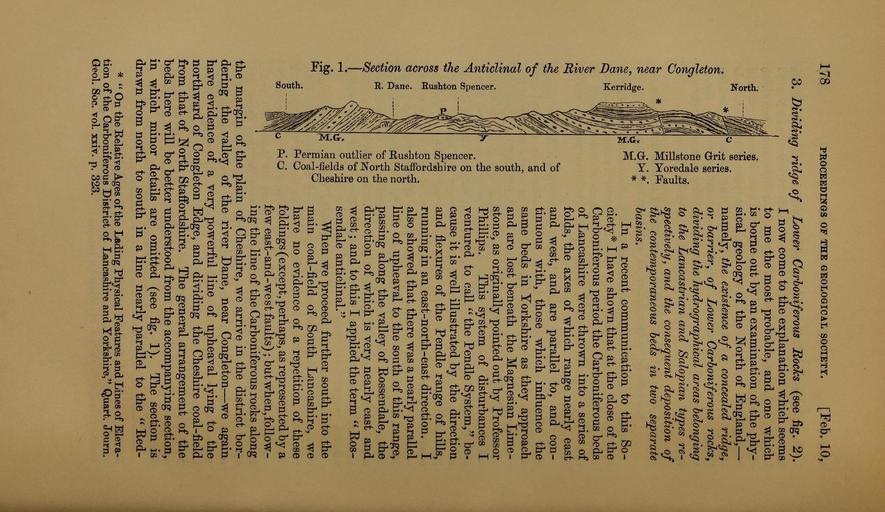MAKE A MEME
View Large Image

| View Original: | The_Quarterly_journal_of_the_Geological_Society_of_London_(12961560064).jpg (2048x1185) | |||
| Download: | Original | Medium | Small | Thumb |
| Courtesy of: | commons.wikimedia.org | More Like This | ||
| Keywords: The Quarterly journal of the Geological Society of London (12961560064).jpg 178 <br> PROCEEDIITGS OF THE GEOLOGICAL SOCIEXr Feb 10 <br> -to <br> Si <br> O H ' <br> 3 Dividing ridge of Lower Carhoniferous Rocks see fig 2 <br> 1 now come to the explanation which seems <br> to me the most probable and one which <br> is borne out by an examination of the phy- <br> sical geology of the North of England ” <br> namely the existence of a concealed ridge <br> or harrier of Lower Carhoniferous rocks <br> dividing the hydrograj hical areas helonging <br> to the Lancastrian and Salojc ian types re- <br> spectively and the consequent deposition of <br> the contemporaneous heds in two separate <br> hasins <br> In a recent communication to this So- <br> M illl/ll'Jif ciety I have shown that at the close of the <br> Carboniferous period the Carboniferous beds <br> of Lancashire were thrown into a series of <br> folds the axes of which range nearly east <br> 'o and west and are parallel to and con- <br> ' tinuous with those which influence the <br> same beds in Yorkshire as they approach <br> -g and are lost beneath the Magnesian Lime- <br> S stone as originally pointed out by Professor <br> rS Phillips This system of disturbances I <br> § g ventured to call the Pendle System be- <br> g g cause it is well illustrated by the direction <br> ' – and flexures of the Pendle range of hills <br> § ' running in an east-north-east direction I <br> rg also showed that there was a nearly parallel <br> fl g line of upheaval to the south of this range <br> o S rS passing along the valley of Rossendale the <br> g j CI direction of which is very nearly east and <br> – 'S © west ; and to this I applied the term Ros- <br> ° r 'M sendale anticlinal <br> s J When we proceed further south into the <br> I main coal-field of South Lancashire we <br> Ph q have no evidence of a repetition of these <br> Pl; q foldings except perhaps as represented by a <br> few east-and-west faults ; but when foUow- <br> ' ing the line of the Carboniferous rocks along <br> the margin of the plain of Cheshire we arrive in the district bor- <br> dering the valley of the river Dane near Congleton ” we again <br> have evidence of a very powerful line of upheaval lying to the <br> northward of Congleton Edge and dividing the Cheshire coal-field <br> from that of North Staffordshire The general arrangement of the <br> beds here will be better understood from the accompanpng section <br> in which minor details are omitted see fig 1 The section is <br> drawn from north to south in a line nearly parallel to the Red- <br> On the Eelative Ages of the Lading Physical Features and Lines of Eleva- <br> tion of the Carboniferous District of Lancashire and Yorkshire Quart Journ <br> Geol Soc vol xxiv p 323 <br> 55 <br> ¢r-l 36103023 111288 51125 Page 178 Text v 25 http //www biodiversitylibrary org/page/36103023 1869 Geological Society of London NameFound Eleva NameConfirmed Eleva EOLID 63992 NameBankID 4545526 Biodiversity Heritage Library The Quarterly journal of the Geological Society of London v 25 1869 Geology Periodicals Smithsonian Libraries bhl page 36103023 dc identifier http //biodiversitylibrary org/page/36103023 smithsonian libraries Information field Flickr posted date ISOdate 2014-03-06 Check categories 2015 August 26 CC-BY-2 0 BioDivLibrary https //flickr com/photos/61021753 N02/12961560064 2015-08-26 15 54 11 cc-by-2 0 PD-old-70-1923 The Quarterly journal of the Geological Society of London 1869 Photos uploaded from Flickr by Fæ using a script | ||||